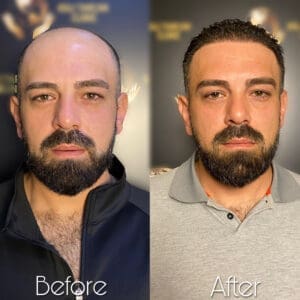Even though a FUE or DHI hair transplant surgery is a minimally invasive procedure, there will still be some swelling in the area, and it will take a few days for the newly transplanted hair follicles to heal properly.
The biggest concern during the first few days after surgery is to avoid any unnecessary stress on the hair and scalp. That is why you will be advised to focus on a specific position and avoid certain things, which we will cover in more detail below.
When Can I Sleep Normally After a Hair Transplant?
During the hair transplant procedure, the surgeon will make thousands of microscopic incisions in the recipient area to implant the grafts from the donor area, and it will take around two weeks to heal. During this time, you have to be extra careful not to put any pressure on the area and avoid any tugging of the hair.
Here is a quick rundown of what position to adopt during the different post-op stages:
- 1–4 Days After: You must keep the head slightly elevated and secured at the back of the neck with pillows so that the top of the head doesn’t touch anything and so that you cannot roll over to the side throughout the night. Lay only on your back at this stage.
- 5–10 Days After: By this time, most of the swelling will have subsided, and you can begin side sleeping, though you must still be careful not to let the top of the head rub against the bed. You should also avoid sleeping on your stomach.
- 14 Days After: From this point on, you will be able to adopt any position that you prefer.
Once a couple of weeks have passed, you will be able to return to your normal routine, but you should still be mindful of sudden head movements and avoid putting pressure on the transplanted hair grafts.
Sleeping After a Hair Transplant: The Dos & Don’ts
Now that you understand the post-op timeline, we can go over a few basic things that you should and shouldn’t do if you want to reduce the risk of complications.
You Should:
- Only lie with the head in an elevated position for the first four nights after the operation.
- Use as many pillows and blankets as you need to prop up your head and make yourself comfortable.
- Place an inflatable travel pillow around the neck to prevent yourself from turning over at night.
- Properly cool and ventilate the bedroom to avoid excessive sweating.
You Shouldn’t:
- Press your head into the bed, rest it against the headboard, or place your arm over the top of the head.
- Make sudden, jerky movements or draw a blanket over your head.
- Use any form of sleeping medication to avoid the feeling of drowsiness that may cause you to bump your head into something.
- Take showers, as hair washing can interfere with the healing process. Use a damp towel to lightly dab the area instead.
As long as you follow these simple tips for the first two weeks following the surgery, you will have a quick and smooth recovery process.
What Is the Best Position to Sleep in After a Hair Transplant?
The most important thing to remember is that you should avoid keeping your head in a fully horizontal position during the first four nights after the procedure. That is because the scalp will be swollen and sensitive, and the grafts won’t yet be fully secured.
You should be lying on your back, and it’s best to have pillows and blankets arranged on either side of your body to prevent you from rolling to the side during the night.
Keeping your head propped up at a 30- to 45-degree angle will reduce swelling and help you heal faster, while also ensuring that the top of your head isn’t pressed against anything. As mentioned, you can use a travel pillow or just several smaller regular ones to help isolate the head in this position and prevent it from turning sideways.
When Are Hair Grafts Secure After a Hair Transplant Surgery?
It generally takes around two whole weeks post-surgery for the recipient area to fully heal and the grafts to be fully secured in their new location. You will notice the swelling slowly going down after a few days, and lots of tiny scabs forming in the area and then falling out over the next ten or so days.
The scalp on the top of your head will look and feel fairly normal after this initial period, and you’ll be able to resume your regular activities and lie in bed in any position you like.

Preparing To Sleep After a Hair Transplant
As long as you remember to adopt the proper position and avoid the things we mentioned above, you won’t have any issues. However, there are two more key points that will help make your life a bit easier and prevent any complications.
Use Clean Sheets and Pillowcases
It’s crucial to keep your bed linens clean to minimize the risk of infection, as your scalp will be quite sensitive and prone to irritation right after the procedure. You can put on new pillowcases every other day during the first week, just to be extra safe, and wash them using a mild detergent without any chemicals that can irritate your skin.
Use Towels to Absorb Drainage
The elevated head position will help drain away the fluid buildup in the scalp that causes swelling. While this is a good thing, it can also stain your sheets and cause discomfort during the night. The best solution is to lay down a towel or two to absorb this fluid.
As you can see, the post-operative care isn’t too difficult, but it’s important to adopt the correct sleeping position and follow all the advice laid out on this page to ensure a quick recovery and the best results after your hair transplant in turkey.

